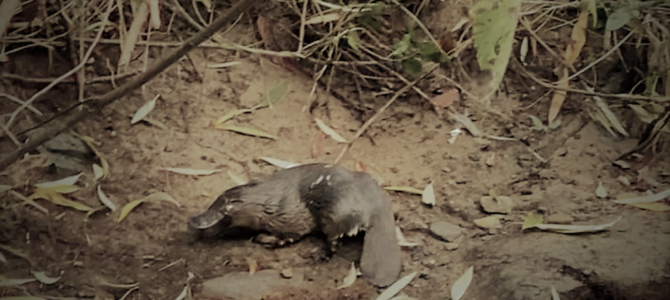by Adele Gonsalvez (2022 Honours Student)
The platypus.
Cute, cuddly, a collection of disparate animal features somehow merged into one animal?
Sure.
Venomous?
Surely not.
But alas, just when you’d thought this Australian native couldn’t get any more bizarre (being egg-laying mammals and all) you’d be surprised again. Unbeknownst to many, the platypus is venomous – in fact, one of only a handful of venomous mammals in existence. Their secret weapon is attached to the ankles of their hindfeet – a spike-like spur connected to a venom gland. By wrapping their legs around their victim, they can jab their spur in and deliver venom into that poor unfortunate soul.
Now, who could possibly on the receiving end of the platypus’ venomous spur? The answer: the platypus. That’s right – the wrath of the platypus (in venom form) is unleashed against other platypuses. Male platypuses to be precise. You see, while female platypuses are born with spurs, they lose them by one year of age, meaning only male platypuses are venomous. The males use their venom against each other when in competition during the breeding season. The solid platypus logic is that in order to increase your own mating success, it helps to get rival males out of the picture – and injecting them with venom that causes temporary limb paralysis and a lot of pain, is an effective way to achieve this.
Now, should you be adding the platypus to your “Aussie animals who can kill me” list? Not quite. Platypus venom is yet to cause any human fatalities, and platypus envenomation in humans is quite rare. But it still packs a mean punch. Excruciating pain unable to be relieved by painkillers or first aid, and symptoms including nausea and gastric pain possibly persisting for weeks, certainly doesn’t sound like an enjoyable experience. In those few cases of humans being on the receiving end of platypus venom however, it generally only occurs when humans are physically handling platypuses, often zookeepers or fisherman. So, keep your hands to yourself and you should be right.
If you are ever lucky enough to see a platypus in the wild, floating down a river or chilling on the banks, there’s no need to be afraid. Just give the little guy some personal space and you should be at no risk of experiencing platypus venom.
Unless you are another male platypus during breeding season – well, in that case…
You should be afraid.
Author

Adele Gonsalvez (2022 Honours Student) is investigating the expression and the antimicrobial activity of defensins from the platypus and short-beaked echidna.
Platypus photo by Kimberley Bateley
